This tutorial is a companion to the forehand loop vs backspin – side view tutorial, but showing a front view instead. Rather than repeat much of the side view version, I’ll just be pointing out items that are relevant to the front view.
Ready Position
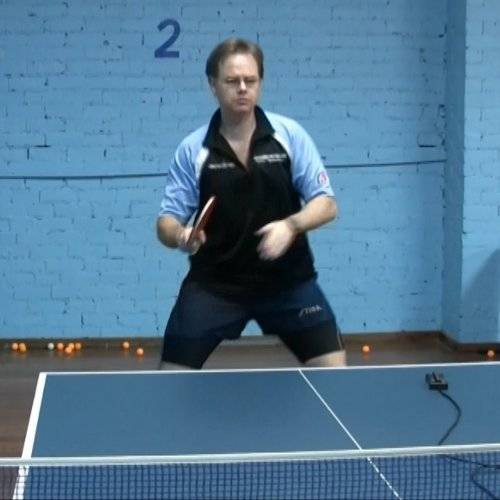
© Greg Letts
Points to look for:
- The player is pictured in mid-bounce, so his knees will bend a little as he comes back down to the ground.
- The player is using a robot to simulate a push drill, so he knows that the next ball is coming to his forehand side. This is why his racket angle is turned slightly to a forehand tilt. Against a live opponent in a match the racket edge would tend to be much more neutral – i.e. vertical.
- The free arm is already pointing a little to the player’s right, since the player has already begun to prepare for his backswing.
Start Of Backswing
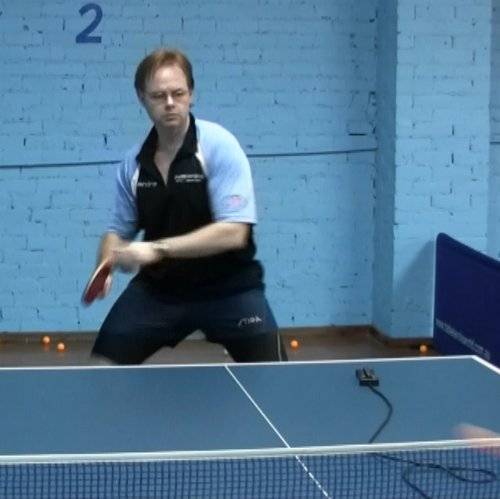
© Greg Letts
The backspin ball is coming to the forehand side and the decision has been made to play a forehand loop. The backswing begins the stroke.
Points to look for:
- As mentioned on the previous page, the player has finished his bounce, and his knees have bent as he takes up his position for the stroke.
- The hips, waist and shoulders have turned to the player’s right, although the head is still facing forward watching the ball.
- The bat has only moved slightly backwards and downwards at this point.
- The free arm is now pointing out to the player’s right. This is not an essential part of the stroke, but just the way that this player tends to move his free arm during a forehand loop. It would also be perfectly acceptable to have the free arm pointing roughly in synch with the racket arm at this point.
- The right shoulder has also dipped slightly. This also is not an essential part of the stroke, but is a habit of the player, which he developed in previous years in order to help lower his racket without having to bend his knees as much. It would be better to develop enough leg strength to allow the racket to be dropped by lowering the body via the knees, rather than dipping the shoulder.
End Of Backswing
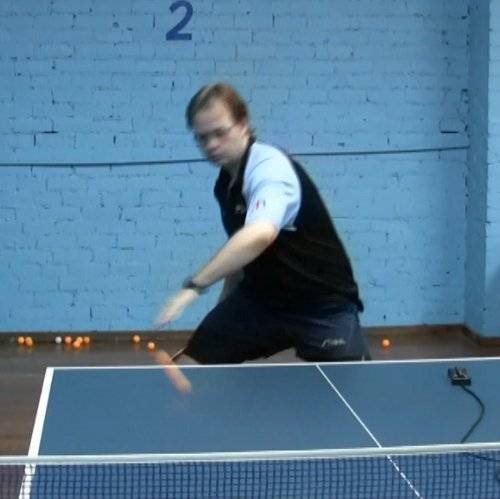
© Greg Letts
The ball has just bounced on the table, and the backswing has finished.
Points to look for:
- The player has continued to turn his shoulders to his right, so now his left shoulder is actually pointing towards the bounce of the ball.
- The racket has been lowered into position behind the player’s right knee, at around knee height. Bringing the racket further behind the body would make swinging forward and generating topspin more difficult, unless a sidespin loop was being attempted.
- The head has turned to follow the ball flight closely.
- The player has bent his knees a little more to further lower his body.
Start Of Forward Swing
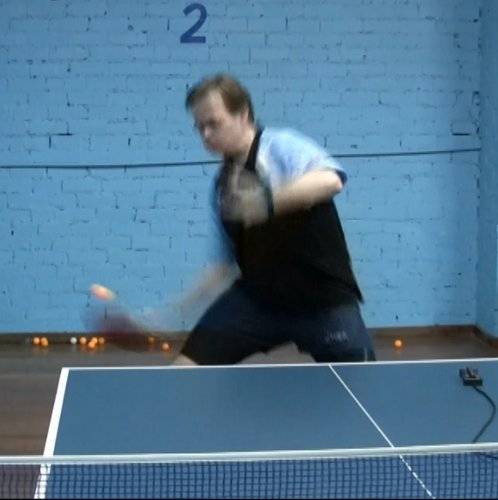
© Greg Letts
The ball is moving towards the hitting zone, and the player has begun his forward swing.
Points to look for:
- To begin the forward swing, the player has begun to push up with his legs, and the free arm has been swung upwards and to the player’s left.
- The racket is being swung forwards and upwards quickly around the elbow joint, with a little movement of the upper right arm as well.
- The player is continuing to watch the ball closely.
- There is a little body turn back to the player’s left, but not all that much just yet.
Contact With The Ball

© Greg Letts
The player has made contact with the ball.
Points to look for:
- The free arm has performed its job of starting the forward swing, and now is relatively still.
- There is not much turning of the body back to the player’s left. This is because the player is focusing on swinging mainly upwards and slightly forwards in order to produce a medium speed ball with heavy topspin, so he does not need much body turn at contact. If the player wished to produce a ball with more speed, he would use more body turn and a slightly flatter swing.
- The right forearm and bat are moving very quickly, while the right upper arm is moving relatively slowly in comparison. This is because the right wrist and forearm are being snapped around the elbow, while the arm is not being swung around the right shoulder very much at all.
- Note how far to the side of the player’s body contact is made with the ball – it is well outside his right knee.
- This particular player uses an arm that is slightly bent at contact, while other players have their playing arm closer to being straight, and yet others have a playing arm closer to a 90 degree bend. The amount of bend in the arm is up to the preference of the player. A straight arm at contact usually takes more time to swing, and requires better footwork to compensate for the extra time needed, but produces more power and spin.
- The player’s head is still paying attention to the hitting zone.
Middle Of Follow Through

© Greg Letts
The ball has been struck, and the player is in the middle of his follow through.
Points to look for:
- The relatively small blur trail of the ball in comparison to the blur trail of the racket confirms that the high racket speed has been converted into a heavy topspin and only medium speed return.
- The racket has begun to move to the player’s left, as it naturally reached the point where it could no longer be comfortably swung forwards. It is still moving upwards, as the hand is swung around the elbow joint.
- The right elbow and shoulder have moved a few inches upwards, due to the upward force of the swing.
End Of Follow Through
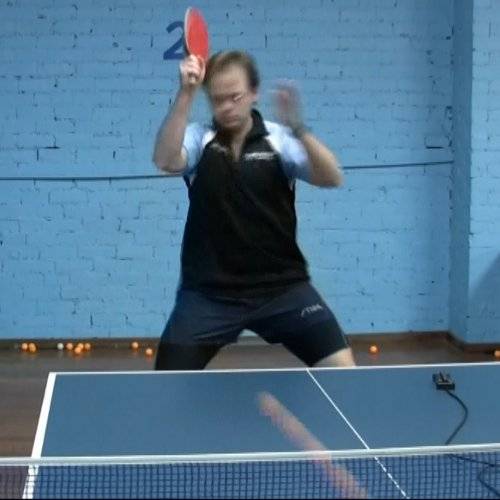
© Greg Letts
The forward swing has come to an end, and the ball is on its way over the net.
Points to look for:
- The player is just starting to turn his head so that he can watch what is happening on the other side of the table.
- The right shoulder has been raised, and is now a little higher than the left shoulder. This is due to the player using the lifting of the right shoulder out of the dip to provide a little extra lift to the ball.
- The shoulders have been turned to the player’s left, as the force of the swing starts to turn the player back towards his ready position.
- The player has kept his right elbow below shoulder level. This allows for a swift recovery to his ready position. A very powerful stroke might see the right elbow lift higher, but it will take longer to recover.
- The player is now up on his toes, or possibly even airborne at this point.
Start Of Return To Ready Position
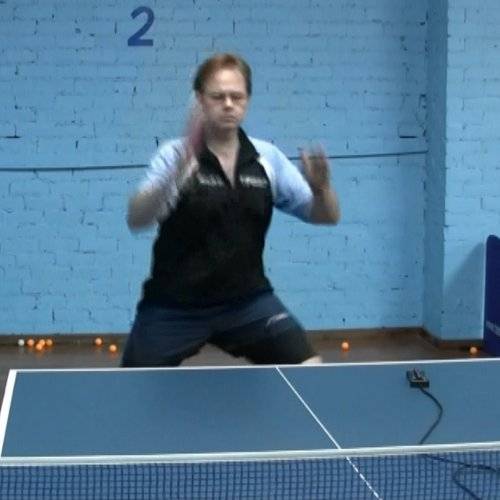
© Greg Letts
The player is in the middle of his return to a basic ready position.
Points to look for:
- The force of the forward swing has rotated the player past his original starting position a little, but the player will bounce and turn a little to his right while the opponent is playing the ball.
- The player is dropping his hands, which is all he needs to do to allow them to get back to their ready position.
- Note that although the player has over-rotated a little (which is fairly common and not a fault), the player has not leant to his left, so his balance is still very good overall, making recovery an easy process.
Return To Ready Position
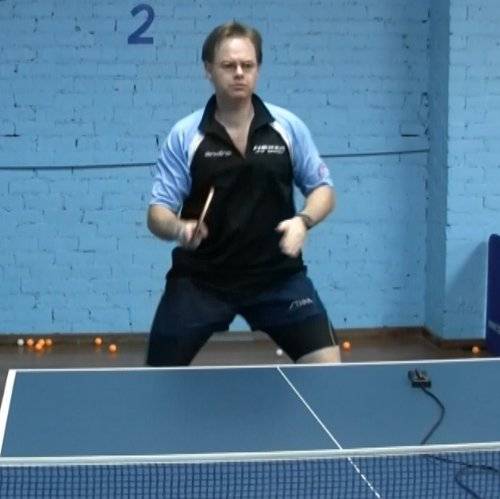
© Greg Letts
The player has almost returned to the ready position.
Points to look for:
- The player is once again pictured in mid-bounce, and has used the bounce to correct his over-rotation and turn back to his right and return to a neutral ready position.
- The arms have continued to drop towards their ready position. The bat is in a neutral position from a left/right perspective, from which it is equally easy to play a forehand or backhand stroke. However, the player is holding it in a slightly forehand tilt, since he knows the next ball is coming to his forehand from the robot.
- The player is now watching the ball coming towards him.

